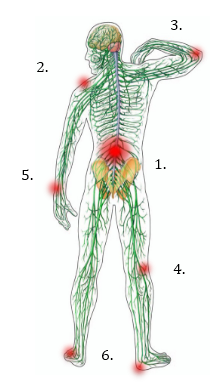“…4..!!..” Body Stress and Golfers
Golfing is stressful!
According to the American Orthopaedic Society for Sports Medicine, low back pain is the most common injury or complaint among both professional and amateur golfers, followed by injuries to the upper extremity (elbow and shoulder). Over exertion, poor technique, tripping, carriage of heavy bags was the main factors in these injuries. It appears that golfers who carry their own bag have twice the incidence of back, shoulder, and ankle injuries compared to those who do not to carry their bag.
Add to fact that golfers who have inflexible hips are subject to lateral sway (unnecessary motion during the back swing) and more challenges are placed on vulnerable parts of the human body, such as the lower lumbar spine.
How can Body Stress Release help you?
Most of the stresses golfers are prone to are as a result of mechanical stress due to playing the game. There is also emotional and chemical stress that can also be locked into the body, possibly due to a bad over-par round and one too many at the 18th! Body Stress Release may be able to assist in unlocking tension in the muscles and assist in sports injury rehabilitation.
Golf Related Body Stress
There are six major areas in the body where golfers suffer the most due to the rigours of playing rounds of golf:
Lower Back
Muscles along the spin and in the sacrum can easily become stressed, due to repeated bending and twisting of the golfer’s swing.
Neck & Shoulders
The neck is also a vulnerable spot and will immediately grab your attention when it hurts. The actions of driving and putting can cause your neck to twist and turn in ways it may not be used to, causing one of several golf-related neck injuries. The rotator cuff is a collection of muscles in the shoulder whose tendons of can become torn as a result of injury, stress or repetitive motion.
Golfer’s Elbow
Pain and discomfort from golf elbow can be enough to make a golfer want to put his clubs away. Similar to tennis elbow, players who repeatedly hinge their wrists or clench their fingers can develop golfer’s elbow. This can cause pain on the inner side of your elbow and can extend to your forearm.
Knees
Knees are stressed due to the pivoting and twisting motion during the golf swing, often resulting in torn ligaments.
Wrists
Tendonitis is common in golfers, which can easily become inflamed, often attributed to over use and improper technique.
Feet
Feet are in a constant state of attrition and which may result in plantar fasciitis on the heel; ’pinched nerves’ in the toes; and pain in the big toe, all resulting from the twisting in the final follow through of the swing.

Tips to avoid golfing stress and injury
- Overuse is a key factor in golf injuries, don’t play or practice too much!
- Correct technique is important to avoid repeatedly stressing areas of the body incorrectly.
- A warm-up technique will have a significant effect in reducing potential strains and injury.
- A game of golf may take 200 swings, which are all in one direction. Reverse practice swings while waiting to play could balance this out and might develop more symmetrical muscle tone and strength.
- Golf bag carriage places undue load on one side of the spine; avoid this where possible – use a trolley or cart.
- Beware of playing conditions; adversely hot weather and hard ground impact injuries are factors in stress and injury.
- Off the golf course – taking care of the lower lumber spine to ensure strength, your BSR practitioner can advise on posture and exercises.
NOTE: Body Stress Release is not a diagnosis or treatment of any condition or disease. It is concerned only with locating and releasing stored tension, so that the body is assisted in its in-built ability to maintain and heal itself.
Case Study: Tiger Woods Injuries
Looking back at Woods’ history of injuries, it started in 2007 when he tore the anterior cruciate ligament in his left knee. Followed by a double stress fracture in the same leg in 2008. He also required season-ending knee surgery.
Six months later Woods tore his right Achilles’ tendon and in 2010, an inflamed disc in his neck halted a final round. Further injuries of a sprained left knee while hitting a shot, and a left Achilles tendon that ceased his play at Doral followed by a left elbow strain at the AT&T National in 2013. As you can see, golf has its own set of injuries to contend with along the path to greatness – even if you are not Tiger Woods!
Information Based on: British Medical Journal article A survey of golf injuries in amateur golfers, by M E Batt, MRCGP, Dop Sports Med, 1992.
